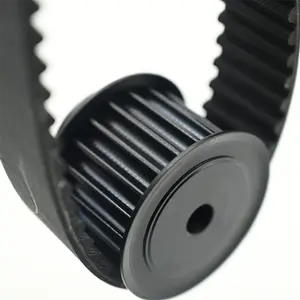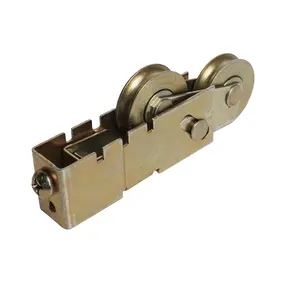Pulley wheels emerge not merely as components within machinery but as silent architects of efficiency and precision in mechanical systems. As technology continues to advance, pulley wheels stand as timeless contributors to the seamless functioning of machinery, silently facilitating the movement and force transmission that underpin various aspects of our daily lives.
Types of pulley wheels
Pulley wheels come in a variety of types, each tailored to specific applications. Fixed pulleys, movable pulleys, and compound pulleys each serve unique roles in mechanical systems. Fixed pulleys change only the direction of force, making them ideal for redirection. Movable pulleys, on the other hand, provide mechanical advantage by reducing the force needed for lifting. Compound pulleys combine fixed and movable elements, amplifying their utility. From industrial machinery to simple household applications, sheave wheels find their place in an array of settings, contributing to smooth operations and efficient power transmission.
Advantages of the pulley wheel
The advantages of integrating pulley wheels into mechanical systems are manifold. The very first benefit is the enhanced mechanical advantage achieved through their application, making tasks like lifting heavy loads more manageable. Pulley wheel systems also contribute to increased precision and control over motion, essential in scenarios where accuracy is paramount. Reduced friction and wear in well-designed pulley systems result in longevity and minimal maintenance requirements, adding to their overall reliability.
Application of pulley wheel
The applications of pulley wheels span a multitude of industries. From manufacturing and construction to transportation and household machinery, pulley wheels play a vital role in simplifying complex tasks. Conveyor systems in factories, lifting mechanisms in construction sites, and even exercise equipment in fitness settings leverage the efficiency of pulley wheels. Their adaptability across diverse domains showcases their versatility and indispensability in modern mechanical systems. Whether it's a single fixed pulley providing redirection or a complex system of multiple pulleys offering mechanical advantage, their designs are tailored to enhance efficiency and precision in various applications.
Pulley wheels emerge not merely as components within machinery but as silent architects of efficiency and precision in mechanical systems. As technology continues to advance, pulley wheels stand as timeless contributors to the seamless functioning of machinery, silently facilitating the movement and force transmission that underpin various aspects of our daily lives. Types of pulley wheels Pulley wheels come in a variety of types, each tailored to specific applications. Fixed pulleys, movable pulleys, and compound pulleys each serve unique roles in mechanical systems. Fixed pulleys change only the direction of force, making them ideal for redirection. Movable pulleys, on the other hand, provide mechanical advantage by reducing the force needed for lifting. Compound pulleys combine fixed and movable elements, amplifying their utility. From industrial machinery to simple household applications, sheave wheels find their place in an array of settings, contributing to smooth operations and efficient power transmission. Advantages of pulley wheels The advantages of integrating pulley wheels into mechanical systems are manifold. The very first benefit is the enhanced mechanical advantage achieved through their application, making tasks like lifting heavy loads more manageable. Pulley wheel systems also contribute to increased precision and control over motion, essential in scenarios where accuracy is paramount. Reduced friction and wear in well-designed pulley systems result in longevity and minimal maintenance requirements, adding to their overall reliability. Application of pulley wheels The applications of pulley wheels span a multitude of industries. From manufacturing and construction to transportation and household machinery, pulley wheels play a vital role in simplifying complex tasks. Conveyor systems in factories, lifting mechanisms in construction sites, and even exercise equipment in fitness settings leverage the efficiency of pulley wheels. Their adaptability across diverse domains showcases their versatility and indispensability in modern mechanical systems. Whether it's a single fixed pulley providing redirection or a complex system of multiple pulleys offering mechanical advantage, their designs are tailored to enhance efficiency and precision in various applications. When it comes to the selection of pulley wheels involves a nuanced understanding of specific requirements. Factors such as load capacity, material composition, and the environment in which the pulley wheel will operate are crucial considerations. For heavy-duty industrial applications, durable metal pulley wheels such as steel or cast iron might be preferable. At the same time, lighter loads might warrant materials like nylon pulley wheels or aluminum pulley wheels. The number of pulleys in a system, their arrangement, and the type of belt or rope used all contribute to the overall efficiency of the pulley system. Factors such as load capacity, material composition, and the environment in which the pulley wheel will operate are crucial considerations. For heavy-duty industrial applications, durable metal pulley wheels such as steel or cast iron might be preferable. At the same time, lighter loads might warrant materials like nylon pulley wheels or aluminum pulley wheels. The number of pulleys in a system, their arrangement, and the type of belt or rope used all contribute to the overall efficiency of the pulley system.




































 浙公网安备 33010002000092号
浙公网安备 33010002000092号 浙B2-20120091-4
浙B2-20120091-4